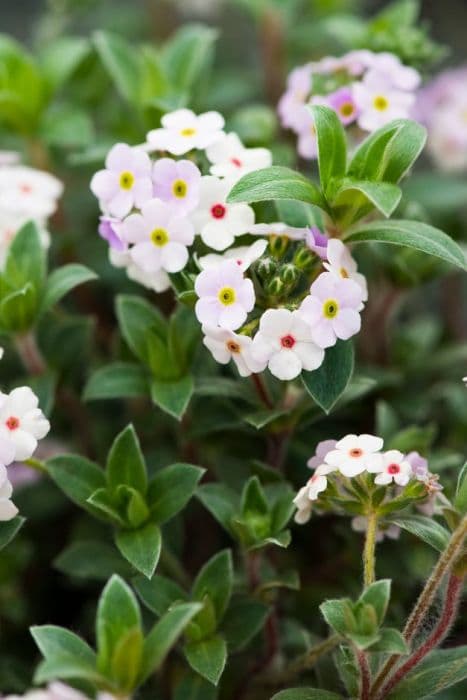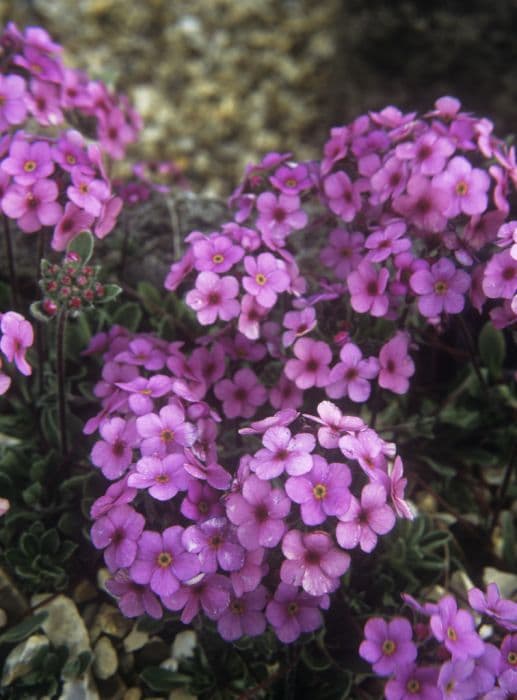Primrose Primula vulgaris subsp. vulgaris (Pr/prim)

ABOUT
Primula vulgaris subsp. vulgaris, commonly known as the common primrose, is a perennial plant that adds a touch of spring cheer with its delightful flowers. The plant features a rosette of tongue-shaped, wrinkled leaves that are rich green in color with a somewhat velvety texture. These leaves hug the ground, forming a lush and appealing base. Rising above the foliage, the common primrose blooms with single, delicate flowers borne on slender, upright stems. Each flower consists of five rounded petals that come together to form a tube-like structure at the back. The petals display a range of colors, often in pastel shades, with the most typical being a soft yellow. However, the flowers can also be found in white, pink, purple, and red hues, with some varieties exhibiting a beautiful pattern or a darker center known as the "eye." The heart of the primrose flower contains a small, yellow center made up of stamens and a central pistil, which are the reproductive parts of the plant. This center is surrounded by a pale, often lighter-colored halo that emphasizes the bright core of the flower, making it look clean and fresh. The common primrose is not only a feast for the eyes but also for the nose, as it emits a light, sweet fragrance, especially in the evening. This aroma adds another layer of enjoyment to gardens and green spaces where these charming plants are found.
About this plant
 Names
NamesFamily
Primulaceae
Synonyms
Common Primrose, English Primrose, Wild Primrose
Common names
Primula acaulis (L.) Hill, Primula veris var. acaulis L., Primula vulgaris var. acaulis (L.) G. Lawson.
 Toxicity
ToxicityTo humans
Primrose is not considered highly toxic to humans. However, some people may experience mild discomfort if they ingest the plant or have skin contact with it. Symptoms of mild poisoning could include nausea, vomiting, or diarrhea. Also, handling the plant may cause skin irritation or an allergic reaction in some individuals due to the presence of the compound primin. If any part of the plant is ingested or if a skin reaction occurs, medical advice should be sought.
To pets
Primrose is generally not toxic to pets, but as with humans, some animals might still experience mild gastrointestinal upset if they ingest the plant. Symptoms could include vomiting or diarrhea. Additionally, similar to humans, some pets might have an allergic reaction to the plant on their skin. If you notice your pet has ingested primrose and is showing signs of illness, it is best to consult a veterinarian.
 Characteristics
CharacteristicsLife cycle
Perennials
Foliage type
Evergreen
Color of leaves
Green
Flower color
Yellow
Height
6 inches (15 cm)
Spread
10 inches (25 cm)
Plant type
Herb
Hardiness zones
5
Native area
Europe
Benefits
 General Benefits
General Benefits- Ornamental Value: Pr/prim adds color to gardens and landscapes with its early spring blooms.
- Attracts Pollinators: Bees and butterflies are drawn to Pr/prim for its nectar, aiding in pollination.
- Ground Cover: Pr/prim can form a carpet of foliage and flowers, suppressing weeds and preventing soil erosion.
- Seasonal Interest: Pr/prim is one of the first plants to flower in spring, bringing life to dormant gardens.
- Edible Flowers: The blooms of Pr/prim are edible and can be used to embellish salads and desserts.
- Cultural Significance: Pr/prim often features in traditions and folklore, symbolizing the arrival of spring and new beginnings.
- Low Maintenance: Pr/prim is easy to care for and requires minimal upkeep once established in the right conditions.
- Diversity: Pr/prim has many cultivars offering a variety of colors and forms to suit different garden designs.
- Habitat Support: Pr/prim provides shelter and food for various small insects, contributing to biodiversity.
- Container Gardening: Pr/prim is suitable for pots and containers, allowing for decorative flexibility and mobility.
 Medical Properties
Medical Properties- Anti-inflammatory: Primrose, or Pr, has been used traditionally to reduce inflammation, especially in conditions like arthritis.
- Diuretic: It promotes the production of urine, helping in the relief of fluid retention.
- Expectorant: The plant has properties that may help in clearing mucus from the respiratory tract.
- Sedative: There are claims that primrose has mild sedative effects, which might help to soothe nerves and promote better sleep.
 Air-purifying Qualities
Air-purifying QualitiesThis plant is not specifically known for air purifying qualities.
 Other Uses
Other Uses- The flowers of Primula vulgaris, commonly known as primrose, can be used to make a yellow natural dye for fabrics. The color obtained from the flowers varies depending on the mordant used.
- Primroses can be used in salads as edible flowers to add a splash of color and a mild, lettuce-like flavor to various dishes.
- The flowers have been traditionally used to make primrose wine, offering a unique flavor derived from these spring blooms.
- These plants are used in companion planting to attract beneficial insects to the garden, such as butterflies and bees, which help with pollination.
- Primrose petals can be crystallized with egg whites and sugar to create decorative cake embellishments or sweet treats.
- In some cultures, primroses are used to decorate wedding cakes or to make romantic floral arrangements due to their association with love and admiration.
- During Victorian times, children would thread the flowers to make fairy necklaces, reflecting the folklore surrounding primroses and their magical connotations.
- Primrose leaves can be used to create a natural polish for wooden furniture when rubbed directly onto the surface.
- They can be placed in planters and hanging pots to create living floral displays that bring a touch of spring indoors.
- Primroses are sometimes used in bathwater for their mild scent and skin-softening properties, creating a calming and aesthetically pleasant bathing experience.
Interesting Facts
 Feng Shui
Feng ShuiThe Primrose is not used in Feng Shui practice.
 Zodiac Sign Compitability
Zodiac Sign CompitabilityThe Primrose is not used in astrology practice.
 Plant Symbolism
Plant Symbolism- Hope: Primroses often symbolize hope due to their early spring blooming, signalling the end of winter and the arrival of new life.
- Youth: The primrose, being one of the first flowers to bloom in spring, is associated with youth and renewal.
- New Beginnings: Their early appearance in the year makes them a symbol for new beginnings or starting fresh.
- Love: In some contexts, primroses can represent young or first love, possibly influenced by their association with the freshness of spring.
 Water
WaterThe common primrose, or Primula vulgaris, prefers consistently moist soil without being waterlogged. Water the plant thoroughly whenever the top inch of soil feels dry to the touch. In general, this may mean watering with approximately 16 ounces of water every week, but this can vary depending on environmental conditions like humidity and temperature. It's crucial not to let the soil dry out completely but also to avoid overwatering which can lead to root rot.
 Light
LightPrimula vulgaris thrives in dappled sunlight or partial shade. It's best situated in a place where it can receive morning sunlight and shade in the hot afternoon. An eastern or northern exposure that provides bright but indirect light is ideal for the common primrose to flourish.
 Temperature
TemperatureThe common primrose is hardy and can tolerate a temperature range from as low as 20 degrees Fahrenheit to as high as 80 degrees Fahrenheit. However, the ideal temperature for Primula vulgaris is between 50 and 70 degrees Fahrenheit. It's important to protect the plant from extreme heat which can cause stress and scorching.
 Pruning
PruningDeadheading, or removing faded flowers of the common primrose, encourages more blooms and prevents self-seeding. Lightly prune back the foliage after flowering to maintain a tidy appearance and promote new growth. The best time to prune is immediately after the blooming period ends.
 Cleaning
CleaningAs needed
 Soil
SoilThe Common Primrose (Primula vulgaris) thrives in well-draining, moist soil that is rich in organic matter. A mix containing peat, loam, and sand in equal parts is ideal. The soil pH should be slightly acidic to neutral, ideally between 6.0 and 7.0 for optimal growth.
 Repotting
RepottingCommon Primroses should be repotted annually or biennially. They benefit from fresh soil and a slightly larger pot to accommodate root growth. The best time to repot is just after flowering or in early fall.
 Humidity & Misting
Humidity & MistingCommon Primroses prefer a moderately humid environment to mimic their natural woodland habitat. They thrive when humidity levels are around 50-60%. Avoid placing them in overly dry environments.
 Suitable locations
Suitable locationsIndoor
Place in bright, indirect light with cool temperatures for indoor Common Primroses.
Outdoor
Partial shade with moist, fertile soil suits outdoor Common Primroses.
Hardiness zone
4-8 USDA
 Life cycle
Life cyclePrimula vulgaris subsp. vulgaris, commonly known as the common primrose, begins its life cycle as a seed that germinates in the spring or early summer, often after a period of chilling which breaks seed dormancy. The seedlings grow into a rosette of leaves close to the ground, which persists through the year and can survive mild winters. In early spring, the plant develops flowering stalks with a single, fragrant flower at the tip of each stalk. After pollination, which is primarily by insects, the flowers develop into capsules containing numerous tiny seeds. The plant spreads both by these seeds and vegetatively through its rhizome, forming clumps. Throughout its life, the common primrose requires moist, well-drained soil and dappled shade to thrive, and after setting seed, the plant will often die back, especially in hotter climates, to re-sprout from its rhizome the following spring.
 Propogation
PropogationPropogation time
Spring-Early Summer
Primula vulgaris subsp. vulgaris, commonly known as the common primrose, is often propagated by division, which is a popular method for this perennial plant. The best time to divide common primroses is typically after they have finished flowering in late spring or early summer. To propagate by division, carefully lift the plant from the soil, ensuring to keep as many roots intact as possible. The clump can then be gently teased apart into smaller sections, each with a portion of the root system. These sections can be immediately replanted in well-prepared soil at the same depth they were originally growing. Water the new divisions thoroughly to help establish them in their new locations. Division not only helps to propagate the plant but also rejuvenates older clumps that may have become woody or less vigorous, encouraging a fresh burst of growth and flowering.









